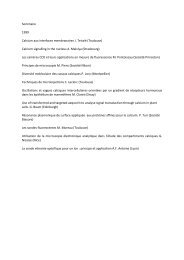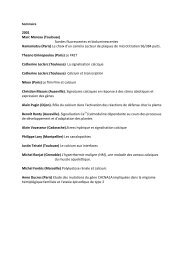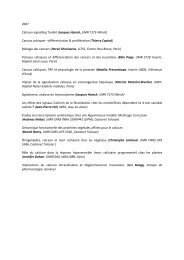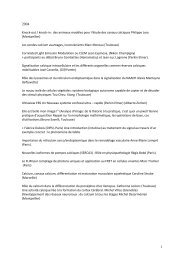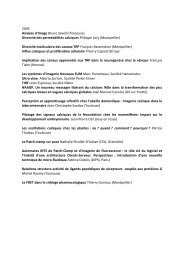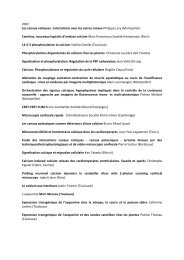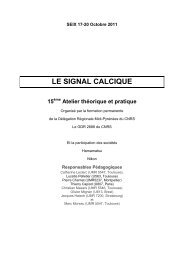SEIX 17-20 octobre 2005 - Atelier Calcium
SEIX 17-20 octobre 2005 - Atelier Calcium
SEIX 17-20 octobre 2005 - Atelier Calcium
Create successful ePaper yourself
Turn your PDF publications into a flip-book with our unique Google optimized e-Paper software.
of both the transcription and alternative splicing of nAChR subunits in Cha-1 neurons. The<br />
expression of the D 2, D 6, D 7, D 1 and D 2 subunits is also detected in embryonic and<br />
larval Cha-1 RNA by microarray analysis. The D 2 and D 2 subunits are the most<br />
abundantly expressed subunits at both developmental stages. By combining calcium imaging<br />
and knock-down of individual nAChR subunits by RNA interference (RNAi), we have shown<br />
that a reverse genetic approach can be used to demonstrate roles for the D 2 and D 6 nAChR<br />
subunits in cultured Cha-1 neurons.<br />
THE INTERACTOME AND GENOME-WIDE RNA INTERFERENCE: PROSPECTS<br />
FOR IDENTIFYING NOVEL CALCIUM SIGNALLING/MODULATING<br />
COMPONENTS<br />
The ease with which RNAi can be applied to S2 cells makes them particularly suitable for<br />
genome-wide RNAi screens. Genes affecting calcium signalling can be detected in a number<br />
of ways. The most obvious is to look for genes whose knockdown results in an abolition of<br />
store-operated entry. This has been done in one study [7] by applying dsRNA for each gene<br />
to S2 cells and subsequently using FLIPR to measure the calcium transients in response to<br />
thapsigargin-evoked store depletion. The detection of only one gene product (STIM1) using<br />
this approach implies either that only one gene is necessary for store-operated calcium entry<br />
or, more likely, that the screen is not sufficiently sensitive to detect other essential genes, or<br />
that there is a high degree of redundancy in the calcium signalling pathway. The latter can be<br />
addressed using combinatorial RNAi screens, whose scale should perhaps be limited by<br />
restricting the screen to a set selected on the basis of the presence of calcium-binding motifs<br />
or other sequence elements, such as PZD domains, that suggest they might interact with<br />
calcium-binding proteins. Future screens might use a different end-point for the assay, such<br />
as thapsigargin-evoked apoptosis. Thus, the knockdown of genes that regulate calcium<br />
signalling might result in changes in the probability of apoptosis resulting from challenges to<br />
the calcium homeostasis machinery.<br />
In addition to genome-wide screens, more direct approaches combining RNAi and<br />
bioinformatics are possible. Alternatives to genome-wide screens include direct tests of<br />
proteins that are recorded in the Drosophila interactome database as being interactors with<br />
calcium-regulating genes. We have identified a number of genes on the basis of text-mining<br />
approaches, the roles of each of which in calcium signalling can be tested using RNAi.<br />
CONCLUSIONS<br />
1) Drosophila cell lines and cell cultures lend themselves well to RNAi and calcium imaging<br />
studies designed to uncover new calcium signalling components.<br />
2) Genome – wide RNAi screens are feasible and when combined with use of known mutants<br />
will afford functional screens for functionally linked molecules in signalling pathways.<br />
3) Such studies will in future serve as a substrate for systems biology.<br />
REFERENCES<br />
1. Adams M.D. et al (<strong>20</strong>00) Science 287, 2185-2189.<br />
2. Towers and Sattelle (<strong>20</strong>02) Bioessays 24, 1066-1073.<br />
3. Clemens et al. (<strong>20</strong>00) PNAS 97, 6499-6503).<br />
4. Millar et al (1995) 1843-1850.<br />
5. Raymond et al (<strong>20</strong>04) Cell <strong>Calcium</strong> 35, 131-139.<br />
95



